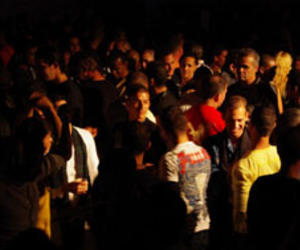Pink Planet at Cuba’s gay oasis
- Submitted by: manso
- Society
- 03 / 19 / 2011

By Julia Steinecke Travel Reporter. SANTA CLARA, CUBA—Crowds of gay and trans people wait outside a ruined hotel with trees growing out the windows. Inside, a disco beat pounds. The throng files in and starts dancing, while a couple of lesbians kiss passionately in the middle of the courtyard. This is not a trendy nightclub in Havana—we’re in a small city in the central province of Villa Clara, an area that many tourists pass through without a second glance. The club is El Mejunje (which means, “The Mixture”) and they’ve been having discos and drag shows here for 20 years.
El Mejunje was founded by Ramón Silverio, an impoverished local kid who loved it when the travelling circus came to town. Silverio worked in education and theatre, and dreamed of a place where artists, rock musicians, drag performers and intellectuals of all kinds could gather and find acceptance.
“Ramón Silverio is a very important cultural figure in Cuba,” a local tourism worker tells me in Spanish; however, the easy-going ambience here is not just because of him. “The city culture is very friendly and accepting; tranquilo,” the worker says. Gays and lesbians can walk on the streets with no fear of violence. Transwomen can dress as they wish—people won’t assault them or call them names, though they may say, “Que bonita!” (“How beautiful!”)
There was a lot of beauty on display during the International Day Against Homophobia last May, when an outdoor drag show outside El Mejunje drew thousands of spectators. It was part of the nationwide celebration organized by CENESEX, the government’s National Centre for Sex Education, under the direction of Mariela Castro Espín, the daughter of President Raúl Castro. She’s helped bring in a number of progressive policies, including free gender reassignment surgery. (Read more about that topic in this previous article about Cuba in Star Travel.)
On an ordinary weekend, Santa Clara’s social life centres on the main plaza, Parque Vidal. Seniors relax on benches or dance to live music, children ride around in miniature donkey carts, and young gay men hang out with friends. Many are students at the Universidad Central Marta Abreu de las Villas, a place that contributes to the city’s open-minded attitude.
My tourism worker friend is pleased with the progress of LGBT rights in Cuba. It’s easier for gay couples to live together now, he explains. They just have to find someone with a spare room to rent them. He tells me about his trans friend who had surgery in Spain and came back to Cuba with a female passport, things which are now possible in Cuba, but take much longer.
With her new ID, she was able to marry a man in Cuba.
I slip away and head back to El Mejunje, which has a full roster of cultural activities during the week: rock, folk, theatre, magicians and senior citizen’s dances. Students are gathering in the café next door to the courtyard, so I join some young women at their table. A man hovers behind me and asks a series of questions in a slurred voice. Am I a journalist? Do I prefer men or women? Would I like to have sex with any of these women?
I ignore him, and chat with my companions, who are students of psychology, journalism, art, and computer science. One wears a winter scarf and a toque marked “CSI Las Vegas.” She picks up a worn guitar and strums a few chords, and her friends sing folk songs. Two women link arms and tell me they are girlfriends. Another pulls out a deck of cards and asks if I’d like to play.
Suddenly I hear a crash and see a body flying across the room. It’s the question-asking guy. Another body lands on top of him, and they roll around on the floor, fighting. Our table slides sideways, scattering the playing cards. We head outside and I decide to call it a night.
A couple of days later, I run into someone who’d been there. He tells me the fighters were thrown out, everyone went back in and everything was fine. He goes to El Mejunje most nights. “It’s my Facebook,” he says.
JUST THE FACTS
SEEING
El Mejunje is located on 12 Marta Abreu , a couple blocks west of Parque Vidal. The gay disco takes place on Saturday nights; drag shows are sporadic. By day, visit the city’s Che Guevara sites: a monument, a mausoleum, a museum and a train wreck.
ARRIVING
WestJet flies from Toronto to Santa Clara between November and April. Viazul ( www.viazul.cu) runs buses from major cities.
Resorts at nearby Cayo Santa María offer excursions to Santa Clara.
SLEEPING
There are several casas particulares (B&Bs) in Santa Clara; check out the list at the bottom of the accommodations website here. Hostal Alba and Florida Center have good food.
Source: www.thestar.com/travel/caribbean/article/955719--pink-planet-cuba-s-gay-...
Comments